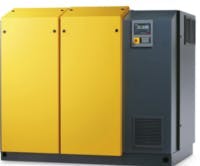Review and comparison of current industrial blower performance standards
The wastewater treatment industry depends heavily upon an efficient source of low-pressure, oil-free air to supply oxygen for the aerobic digestion process of organic matter.
Originally, this low-pressure air was supplied by positive displacement, rotary-lobe blowers, but due to the high volumes of air required for aeration applications, the wastewater industry was quick to adopt the dynamic blower technology, specifically multistage centrifugal blowers. As a result of their success in the wastewater industry, dynamic blowers have achieved widespread acceptance and use throughout general industry.
The need for increased efficiency has driven the innovation of new blower technologies, such as high-speed turbo and low-pressure screw blowers. These technologies have increased performance over time. Such claims have garnered the interest of end users and specifying engineers alike and much discussion has taken place regarding comparing the performance between dynamic and positive displacement blowers.
It is understood that when a user specifies blower performance, they expect the blower manufacturer to deliver the specified performance. This is especially true within the wastewater industry where low-pressure aeration is such a major operating expense for the process.
Accordingly, a valid and reliable means for comparing the performance between different blower technologies is needed so that purchasing and specifying decisions can be based upon facts and data. The challenge in comparing the performance between different blower technologies, such as dynamic and positive displacement, is that they operate under different compression principles. This complicates the testing requirements needed to achieve an accurate performance comparison and leaves room for creative performance reporting.
The next generation of blower standards
The existing performance standards for dynamic compressors (PTC-10 and ISO 5389) and positive displacement compressors (ISO 1217) were developed decades ago.
Although these standards have undergone multiple revisions and amendments over the years, the wastewater industry has been asking for a new, wire-to-air performance test methodology that measures the true package performance of low-pressure air compressors (blowers) and allows for accurate performance comparisons between varying blower technologies.
In response to this challenge, the Compressed Air & Gas Institute (CAGI), the International Standards Organization (ISO), and The American Society of Mechanical Engineers (ASME) have independently developed the following three performance standards for low-pressure blowers:
- ANSI/CAGI BL 300, Performance Test Code for Electric Driven Low Pressure Air Compressor Packages
- ISO 22484, Displacement and Dynamic Compressors – Performance Test code for Electric Driven Low-Pressure Air Compressor Packages
- ASME/PTC 13, Wire-to-Air Performance Test Code for Blower Systems
Consider the example of three people travelling from Miami to Chicago: one driving, one flying, and one taking the train. All three will arrive at the same destination, each just with a different experience in getting there. Similarly, although each testing standard, when properly followed, should render the same performance data when applied to the same blower, each standard has its nuances of difference regarding the methodology of the test.
This article addresses the boundaries that are established for determining what is included in the blower package, how similitude is achieved with each standard, and the data validation that each standard requires to render an apples-to-apples comparison between any two blowers regardless of their technology.
A chart is provided for key point comparison of the three testing standards at the end of the article.
ASME PTC 13 - 2018: Wire-to-Air Performance Test Code for Blower Systems
ASME is well known both domestically and internationally for its test standards.
As the name suggests, the standard focuses on complete blower systems or packages and delivers a performance metric that is a ratio of package input power to outlet flow. This concept is known as “Wire-to- Air” and it deviates from the previous performance standards that focused primarily on the airend performance and not the performance of the complete package.
The intent of the standard is to address the needs of complete machines such as high-speed turbo blowers and screw blowers that are designed, manufactured, sold, and used as complete packages, consisting of blower airend, drive motor, VFD, and package elements. As complete packages, the standard addresses the machines as a box that ingests air, delivers it to a discharge pipe, and consumes power in the effort.
Thermodynamic and electric performance boundaries
The standard establishes the typical boundary layer for a blower system to clearly define what items are considered part of the system/package. Package boundaries are subdivided between a Thermodynamic performance boundary and an Electric performance boundary. The Thermodynamic boundary focuses on the airend and its controls and the Electric boundary focuses upon the drive motor and its controls. These two boundaries have been established to allow the buyer and supplier to negotiate the items to be included with the package test.
The intent is to identify all relevant components required to operate the machine and to include them in both the machine test and the reported data presented in the offering.
Where to collect measurements
The next item of interest and importance is the test setup. To achieve wire-to-air performance the test rig is critically important to ensure that the complete system/package and all affected components are accounted for.
The items to be included in the test have been established by the test boundaries, but the placement of the measurement devices is equally important. The intent here is to capture the suction pressure and temperature before the air reaches the package boundary in contrast to measuring the pressure and temperature of the air at the boundary layer outlet.
Flow is measured downstream of the package boundary and power is measured going into the package boundary. In theory, this allows for all internal flow losses and all power consumers to be accounted for. Pressures and temperatures are required for the accurate conversion of test conditions back to the guaranteed conditions during the data validation process.
How to measure flow
For flow, measuring at the discharge is important because not all of the air ingested at the blower suction flange or machine intake makes it to the outlet port. This airflow can be lost to internal slip or channeled off for cooling or other needs. Measuring in the discharge pipe is the most accurate means to confirm delivered airflow at pressure.
Power measurements
Power measurement is equally important because for many years, blower shaft power had been supplied which was used to theoretically derive a total input power of the package. Now that there are complete machines, the actual machine input power can be measured with a single power meter. All auxiliary pumps, fans, or other devices are power consumers, and these must also be accounted for in the test.
Data validation and methodology
The final part of the standard that will be covered is data validation. The standard provides the methodology required to quantify the thermodynamic properties of operation, points of similitude, and data validation of the test performance back to the projected guaranteed conditions.
This is also where the important comparison metrics are established. In the case of PTC-13, these can be identified as:
- Volume ratio
- Volume flow rate
- Isentropic head (specific performance of wire-to-air)
- Mach number
- Discharge pressure
Volume ratio is utilized as a point of similitude for the air density of the test site conditions to the air density at the guaranteed conditions. All performance tests are intended to take place in a lab that may not duplicate site conditions which will impact performance results.
Volume flow rate is calculated from the measured discharge flow which is converted to inlet flow at test-site conditions for comparison with the guaranteed inlet flow at site conditions. Isentropic head is at the core of this test. This establishes the amount of thermodynamic work required to achieve the requested flow and pressure. For similitude, conditions must be equal at both test sites.
Machine Mach number is again a point of similitude for dynamic machines. This represents the velocity of the air molecules leaving the tip of the rotor. This relates to the fluid compressibility at differing air densities and air densities again come down to test site conditions and guaranteed conditions. Again, for similitude, these should be kept the same between test and guarantee.
These are the foundational elements of the PTC-13 test code.
ANSI/CAGI BL 300 & ISO 22484: Performance Test Code for Electric Driven Low-Pressure Air Compressor Packages
ANSI/CAGI BL 300 and ISO 22484 were developed in response to a recognized need to provide a methodology to correct performance at test sites to expected performance at reference or contract specified conditions for positive displacement and dynamic compression types.
These documents specify the performance test method of electrically driven low-pressure air compressor packages, where the compression is performed by positive displacement or dynamic compression, utilizing atmospheric air as the compression gas. Low-pressure air compressor packages are often referred to as “blowers”.
Similar to the PTC-13 standard, the intent of BL300 and ISO 22484 is to establish a clear package boundary, consistent measurement locations, and total package power consumption. The intent is to test the blower package (system) at the test laboratory exactly as it is to be delivered to the customer. The ISO standard specifically addresses packaged machines. Additionally, the ISO standard has established both key performance indicators and suitable tolerances.
Finding similitude
For similitude, we have the following dimensionless figures:
- Flow coefficient
- Work coefficient
- Mach number (dynamic only)
The flow coefficient is a function of the inlet volume flow and the rotor tip speed. This ensures a balance between the flow velocity and impeller rotational speed.
The work coefficient is a function of the isentropic work and rotor tip speed. This establishes that the machine is performing a similar amount of work at both test and guarantee conditions.
The Mach number only applies to dynamic machines, and it ensures the same flow velocity is occurring at the two conditions.
Positive displacement versus dynamic blowers
Both the CAGI and ISO standards introduce two new developments, one with respect to positive displacement blowers and one with respect to dynamic blowers.
Both standards mathematically model the internal compression that occurs within positive displacement screw blowers. Unlike traditional lobe type blowers, screw machines reduce the air volume which is noted as the internal volume ratio. Since this internal compression must be limited for the blower to achieve high efficiency, the goal is to only compress as much as needed for a given system process.
As a result, many screw blowers compress both internally (isentropically) and externally (isochorically), matching output compression to system pressure. Both CAGI and ISO standards mathematically calculate the influence of both forms of compression on the performance for screw blowers.
The two-speed test
The two-speed test for dynamic machines is another new concept. For variable speed, dynamic, low-pressure blowers, if the conditions at the test site differ significantly from the preconditions of the guarantee, the situation may arise where the limits on the work coefficient, flow coefficient, and machine Mach number exceed the limits imposed on rotational speed.
Although compression efficiency is still comparable, this condition may result in a difference in driver efficiency of the packaged low-pressure blower between test and guarantee conditions, which cannot be neglected. The two-speed test consists of operating the blower at matched Mach numbers speed and then operating the blower at the specified speed. These results are combined to evaluate the package power.
As found in the ISO 1217 annexes, both the CAGI and the ISO standard provide tolerance limits on flow and specific performance (kW/cfm). This allows for a clear indication of performance in data sheets and publications. Provisions also exist for a customer specified agreement.
Two key differences from other standards
These three blower testing standards each address the need for equal machine performance comparison in their own way. Much of the methodology is similar, although there are differences.
Key differences are the metrics used for achieving similarity between the test and the guarantee. Volume flow rates are something that could present problems to suppliers and engineers. The PTC-13 utilizes the specific volume ratio with a +/-5% tolerance. Should test conditions limit the ability for the machine to achieve similarity, the unit is to be run at its highest possible condition before extrapolating to the guaranteed point. The CAGI and the ISO standards approach this via the two-speed test in which the machine is to be operated at two known points of similarity to narrow the margin for error.
Another area of deviation concerns tolerances. The CAGI and the ISO standards approach this from a machine manufacturing perspective with the understanding that testing is time consuming and costly.
Performance testing of smaller machines (less than 100 hp) is not cost effective and often inflates the project cost. As such, the CAGI and the ISO standards offer a gradient of tolerances on flow and specific performance to allow manufacturers to provide realistic performance values given current manufacturing techniques while still posing a significant performance benchmark to achieve.
The PTC-13 standard provides for project specific performance and customer agreed-to tolerances. This may lead to unreasonable performance requirements, excessive penalty clauses, and costly performance tests.
These measures are not unreasonable on large projects, but for smaller projects the cost to achieve these performance goals can exceed the potential operational efficiency savings.
Why develop these blower testing standards?
As large users of low-pressure air, the wastewater treatment industry expects blower manufacturers to produce blowers that deliver the performance that the user specifies.
Blower testing standards are required that allow for the apples-to-apples comparison between any two blowers, whether they are positive displacement machines or dynamic machines. PTC 13, BL300, and ISO 22484 testing standards provide blower testing methodologies that can be used to verify that manufacturers are delivering the performance that they advertise.
This article has identified the differences amongst these standards and outlined how these testing standards intend to satisfy the market need for a simple, reliable, and valid testing standard that allows the accurate comparison between any two blowers.
While the standards mostly accomplish this effort in a similar fashion, the application of similarity laws and acceptance criteria do vary.
PTC-13 has been active in the market since 2019. ANSI/BL300 was published as an American National Standard in 2022 and is available through the CAGI website. ISO 22484 is being finalized and it is expected to be published in 2024.
About the Author
Compressed Air and Gas Institute
The Compressed Air and Gas Institute (CAGI) is the united voice of the compressed air industry, serving as the unbiased authority on technical, educational, promotional, and other matters that affect compressed air and gas equipment suppliers and their customers. CAGI educational resources include e-learning coursework, selection guides, videos, and the Compressed Air & Gas Handbook.
The Blower & Vacuum Section consists of the following member companies:
- Atlas Copco Compressors LLC
- Fruitland Manufacturing
- Gardner Denver Inc.
- Roots Blowers
- Ingersoll Rand
- Kaeser Compressors, Inc.
- MD-Kinney
For more information on CAGI, visit www.cagi.org.



